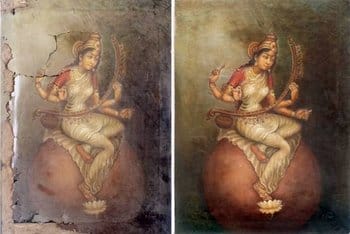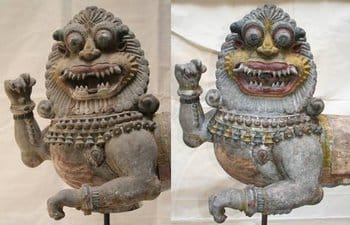In the basement of Chitrakala Parishath, Bangalore is a long narrow room. Unlike regular Saturday mornings, on 17th May 2008 the room is bustling with activity. In one end of the room, members of INTACH Chitrakala Parishath Art Conservation Centre (ICKPAC) are busy packing their materials in cartons. Madhu Rani, who heads the initiative, tells me that they are getting ready for their trip to the Thiruvarur temple scheduled for the forthcoming week.

An oil painting on canvas “Goddess Saraswathi” by artist S.K.Ayya, was received at our centre for restoration. The painting was in an extremely bad condition and it was a challenge to put the painting together. (pic: courtesy ICKPAC)
I settle myself in one of the many chairs facing a table covered with long white sheets in the room and pick up a brochure that introduces the organization. The Indian National Trust for Art and Cultural Heritage (INTACH) is a voluntary organization established in 1984 focusing on developing technical expertise to conserve Natural, Architectural and Material Heritage assets. ICKPAC was established in July 1993 in collaboration with Karnataka Chitrakala Parishath for the conservation and restoration of art collections in South India.
“What we do can be broadly classified as Restoration and Conservation”, Madhu adds as she seats herself next to me and pulls the many layers of white sheets from under my notebook. Under the sheets is a painting that she says is over 150 years old. She deftly points me to certain areas of the paintings where there are holes and faint cracks. “This painting was inside a temple and hence there were layers of soot and burns all over.” She then flips the painting to show me a layer of newspaper. “In the past, newspapers were used to reinforce the paintings, but unfortunately these being highly acidic cause the painting to gradually wither away. What we do is to remove the newspaper and reinforce the painting with Japanese tissue which is acid free”, she adds. In addition, they use a wide variety of chemicals to slowly remove the accretions that have accumulated over time. “We avoid modifying the painting itself until specifically requested by the patron. Even in this case,” she points to a hole in the painting, “we find a paper that is of the similar quality as the original to fill the gap. Whatever that we do is mostly reversible”.”

A wooden polychrome sculpture “Simhavahana” about 200 years old was received at our centre. There were problems such as deposition of dust and dirt, cracks in the wood, loss of cloth (forming the base of the paint layer), flaking and loss of paint, whitish streaks etc. Treatment consisted of cleaning the dust and dirt, filling the cracks, pasting the cloth, consolidating the paint layer, cleaning the whitish streaks. No attempt was made to make the object look new; the authenticity was maintained by carrying out only conservation.(pic: Courtesy: ICKPAC)
She then takes me to a sculpture which she says could be 200 years old. “Here we are not trying to restore the sculpture but are only cleaning it up and strengthening it so that we can conserve the same and improve its longevity”. She points me to specific parts of the sculpture where they have worked on, which look distinctly different from the rest of the sculpture.
I quiz her then about the upcoming trip to Thirvuvarur. “The mural paintings in the ceiling of the Thiruvarur temples have long been neglected. Thankfully, one of the patrons took notice and approached us many years ago to know if we could take up the project. Over the last few years, he has been running post to post with our report to get the approval of concerned government department for approval to start the project. And since the mural paintings on the ceilings cannot be brought here”, she says with the smile, “we are packing all our materials and chemicals to work in the temple premises.”
What kind of skills is required to be a part of ICKPAC? “The people who work with us have either specialized in art or in chemistry. Paintings are of different kinds – oil on cloth, oil on wood, water color – and each of them require a specific set of materials and techniques for their proper conservation. So, it is important to understand the chemicals that one is working with. More than the knowledge, one needs the skill to work with artworks and lots and lots of patience”, she emphasizes. There are currently 10 of them who work full time at ICKPAC. Madhu herself was a student of Chitra Kala Parishath before she took over the responsibilities of running ICKPAC.
I ask if someone like me who’s not trained can help in any way. “We don’t have the bandwidth to train individuals on the core work that we do. However, in many projects we work with volunteers to do the basic tasks. For instance, we recently worked on restoring many manuscripts and had a lot of students working with us on the project. We would love to work with people, maybe over a weekend, based on the needs of the project we have”
Just as I am packing my bags, I wonder aloud about the wealth of information ICKPAC would have gathered over the years working on such artworks, which would be useful for today’s artists. “Absolutely! I think our ancestors had a wealth of information on exactly which materials to use. Which is why so many paintings have survived despite all the torture we put them through. But more than these techniques, what is important is to educate people on the significance of these paintings and sculptures and how they can help preserve them as part of their daily lives.”
Having spent over two hours talking to her in detail about paintings from all over, I ask her whether she would be willing to come and explain in detail about the different paintings and sculptures if we organize a visit to a place of great cultural significance. “Most definitely”, she says and waves me goodbye.
And if there is such a visit, would you be interested?